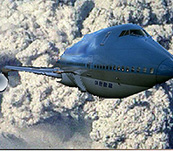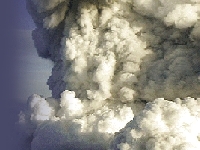 The words «volcanic ash» refer to small particles of pulverized rocks ejected into the atmosphere during
volcanic eruptions. In the case of high explosivity eruptions, ash is blasted up to tens of kilometers high.
The smallest particles, ranging from 1 to 15 µm, can persist in the atmosphere for several days. Ash cloud
shifts following tropospheric or stratospheric winds and is transported over very long distances from the
volcano source. Since the early 80's, about a hundred incidents directly connected to volcanic activity have
affected long haul flights.
The words «volcanic ash» refer to small particles of pulverized rocks ejected into the atmosphere during
volcanic eruptions. In the case of high explosivity eruptions, ash is blasted up to tens of kilometers high.
The smallest particles, ranging from 1 to 15 µm, can persist in the atmosphere for several days. Ash cloud
shifts following tropospheric or stratospheric winds and is transported over very long distances from the
volcano source. Since the early 80's, about a hundred incidents directly connected to volcanic activity have
affected long haul flights.
 They were due to ingestion by the turbine of volcanic ash contaminated air. The ash, mainly made up of silicates,
melts at about 1100°C and fuses on nozzle guide vanes and turbine blades, in the hot section of the engine,
operating about 1400°C at normal thrust. This can cause engine flame out. Earlier generations of jet engines
had a lower operating temperature, and, therefore, were not so much susceptible to this effect. In the most
serious reported incident, all four engines stalled, but, fortunately, the pilot was able to restart two of
the engines once the jet had left the ash contaminated area (after a fall of several thousand meters).
At the present time, no crash due to volcanic ash has been reported but it is easy to understand that
this hazard must not be underestimated.
They were due to ingestion by the turbine of volcanic ash contaminated air. The ash, mainly made up of silicates,
melts at about 1100°C and fuses on nozzle guide vanes and turbine blades, in the hot section of the engine,
operating about 1400°C at normal thrust. This can cause engine flame out. Earlier generations of jet engines
had a lower operating temperature, and, therefore, were not so much susceptible to this effect. In the most
serious reported incident, all four engines stalled, but, fortunately, the pilot was able to restart two of
the engines once the jet had left the ash contaminated area (after a fall of several thousand meters).
At the present time, no crash due to volcanic ash has been reported but it is easy to understand that
this hazard must not be underestimated.
 Beyond the potential for a major accident linked to engine failures, volcanic ash can be a considerable
threat for other reasons. Ash is very hard and extremely abrasive and therefore erodes airframe, flight surfaces,
and jet engine parts. The abrasion of the cockpit windows can lead to reduction or loss of pilots' forward
visibility. As volcanic ash is generally too fine to be stopped by normal filtration systems, it can heavily
contaminate the cooling system, as well as electrical and avionic units, rendering aircraft control difficult.
Lastly, volcanic ash is often accompanied by a very corrosive aerosol of sulphuric acid, H2SO4, coming from
oxidation and hydration of SO2 released during the eruption.
Beyond the potential for a major accident linked to engine failures, volcanic ash can be a considerable
threat for other reasons. Ash is very hard and extremely abrasive and therefore erodes airframe, flight surfaces,
and jet engine parts. The abrasion of the cockpit windows can lead to reduction or loss of pilots' forward
visibility. As volcanic ash is generally too fine to be stopped by normal filtration systems, it can heavily
contaminate the cooling system, as well as electrical and avionic units, rendering aircraft control difficult.
Lastly, volcanic ash is often accompanied by a very corrosive aerosol of sulphuric acid, H2SO4, coming from
oxidation and hydration of SO2 released during the eruption.